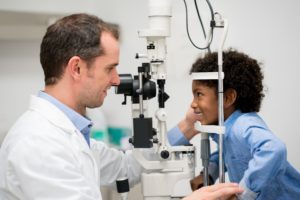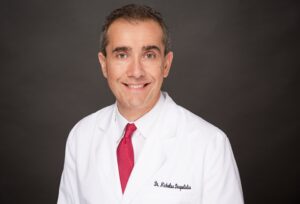November 15, 2023
By Nicholas Despotidis, OD, FAAO, FCOVD, FIAO
You’ll have the most success with myopia management if you hone in on, focus on, and prioritize your patients. I’ve learned that focus is a superpower when done deliberately and consistently.
 My interest and entrance into myopia management came about for two primary reasons. My partner, Dr. Barry Tannen, OD, FAAO, FCOVD, and I opened our practice, Eyecare Professionals, cold in 1988. For ten years we had a very successful primary care practice. We started to notice that as we were getting busier, it didn’t necessarily translate to more profitability. We were working much harder but not seeing that impact our bottom line.
My interest and entrance into myopia management came about for two primary reasons. My partner, Dr. Barry Tannen, OD, FAAO, FCOVD, and I opened our practice, Eyecare Professionals, cold in 1988. For ten years we had a very successful primary care practice. We started to notice that as we were getting busier, it didn’t necessarily translate to more profitability. We were working much harder but not seeing that impact our bottom line.
At about the same time, both my sons became nearsighted, and that’s when my interest in myopia management started growing. At that time, there was some anecdotal evidence that orthokeratology lenses seemed to slow down myopia progression, and my children were 7 and 10 years old, and they were both about -2.00D myopes. I fit them with OrthoK lenses, and they turned out to be very successful. That started a career-long journey for me specializing in myopia management. Once I saw how OrthoK helped my sons, we slowly started to introduce it to our patient base.
That really catapulted our practice into focusing on myopia management. Our practice remains multidisciplinary, but my specialty, my total focus, is myopia management. Since 2002, I’ve been growing our myopia management practice long before specializing in it became in vogue.
Early Days of Myopia Management
When our practice was first starting with myopia management, a lot of what we learned and how we learned it depended on our colleagues. We would attend one convention a year, the Global Orthokeratology Symposium, (currently Vision By Design) and all the OrthoK fitters at the time attended. We listened to every lecture on how to fit these lenses and how they may slow down myopia progression.
We’d all stay in touch after these conferences and ask each other about the lenses we were fitting, the topographers we were using, and general advice on cases we saw in our practices. There was a lot of collegiality that we really depended on. We needed one another to grow our practices, specifically with OrthoK, because it was such a new field, and it wasn’t an accepted field across the eye care industry. When we started fitting it, we looked like charlatans. Doctors weren’t familiar with OrthoK at all. The thought of sleeping with a rigid OrthoK lens was sacrilegious. We really were pioneers in one sense or another. We felt we were in this club and needed to depend on one another for advice.
Myopia Management Consultations Help Educate Parents
Something I’ve realized over the years of doing myopia management is that just because a child is myopic doesn’t mean the child or the parent is going to be interested in controlling myopia. I think that’s a clinical frustration for many optometrists and ophthalmologists. They see a child with progressive myopia, they recommend a form of myopia management, and then the parent doesn’t follow through.
Once I see a child is a candidate for myopia management, I suggest a consultation. I’ve found that it’s too much information to try to explain myopia management and all the different treatments during an exam. When they schedule a consultation, they have an appointment for me to spend about an hour with the child. That’s where I determine what is best for them. During the exam, the only clarification I need to make is that the child’s eyesight is getting worse, and we need to do something about it.
Before the consultation, I do a virtual call with the parent to get a detailed history of their child. During an exam, we may not have the time to answer a lot of the parents’ questions. Then, during the actual consultation, I like to focus on the child. This works well because doctors rarely spend more than five minutes with their patients. I get to ask parents when their child started wearing glasses, if their child is symptomatic, and if they like to wear glasses. This helps me determine some leverage because when I propose my recommendation, it aligns with what is bothering the child or the parent.
Here’s the caveat: this is a lot of work. However, I know if I do an amazing job with this patient, they will refer friends and family. That’s how I built my practice. One happy parent will start talking to other parents on the soccer field, at school, or on social media, and they do a lot of the pre-education for me. This also helps because when parents come in for the consultation, they’re ready to decide, as opposed to just rushing through everything with the child in the exam chair.
Become an Advocate for Your Patients
I think there are two philosophies when it comes to educating patients and their parents about myopia management. Some doctors go into depth on why myopia is a disease — it increases their child’s risk of vision loss due to cataracts, glaucoma, etc. I have never found that to be a successful route. Parents get paralyzed, and they feel guilty.
I focus on things that the parents subconsciously want to know. As a parent, I want to know if I caused my child’s myopia, if buying them an iPad at 5 years old caused their myopia, and if having them focus on getting straight As to get into an Ivy League college caused their myopia. I explain to parents that the environment our children are growing up in is very different from how we grew up. There’s more electronics, which keep children indoors, and there’s a visual consequence to our children staying indoors. I explain that children need outdoor light to help preserve their eyesight, and parents understand that.
I tell them how we can help control their myopia progression, and at every visit, I educate them why their child may be too young to have a smartphone. I remind them that kids need to go outside, not just for their eyes, but for their socialization, for eye contact. I remind them to go outside for their own health. The pandemic wasn’t their friend — we kept our kids inside, we taught them inside, and now we must break that habit. Having a health professional give parents permission to limit their children’s screen time, often empowers them to take control of an area they once feared helpless.
Create an Experience
One of the questions I ask myself is, “Why would patients come to me as opposed to my colleagues around me?” Other doctors may have more convenient hours or lower fees. How do I differentiate my myopia management practice?
The way I’ve done that is with time, the time I spend with my patients and explain my results to parents. That’s the value I bring to my patients. There will always be someone who’s less expensive than you, but you can compete on service, and that’s harder. It’s easier to give a discount. That’s what we try to provide to our patients. I hear many doctors worry about getting busier and busier. You don’t. You need to provide consistent, high quality service to the patients you already have and referrals will follow.
You can’t be everything to everyone, and that’s a widespread issue in optometry right now, in my opinion. We try to do it all: dry eye, medical optometry, glasses, contact lenses, myopia management, vision therapy, etc. You’ll have the most success with myopia management if you hone in on, focus on, and prioritize your patients. I’ve learned that focus is a superpower when done deliberately and consistently.
 |
Nicholas Despotidis, OD, FAAO, FCOVD, FIAO, has one of the largest practices in the country specializing in myopia management. He’s the lead author of two books, My Children are Nearsighted Too and A Parent’s Guide to Raising Children with Healthy Vision. His workshop SuperChargeYourPractice is the most sought-after practice management course offered at the Vision by Design symposium. His TEDx talk “A Childhood Disease Worth Preventing” educates parents on the growing number of children affected by myopia and possible treatments available to them. Learn more about Dr. D and contact him here. |













